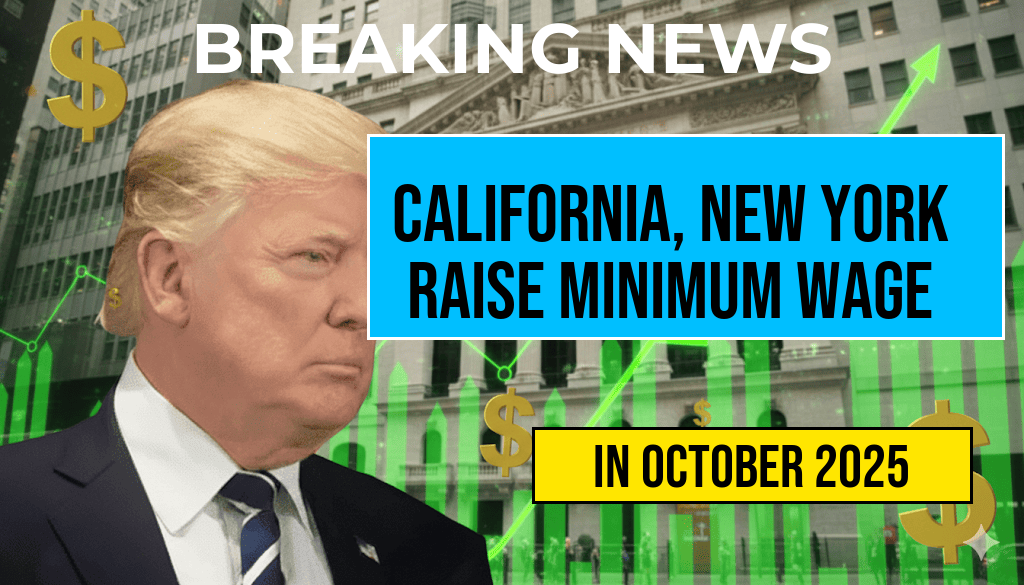California and New York are set to implement significant increases in their minimum wage standards, raising the hourly rate to $16.50 in upcoming legislative cycles. These moves come amid ongoing debates over economic recovery, living costs, and income inequality, reflecting both states’ commitments to improving workers’ earnings. Starting from 2024, California’s wage floor will be adjusted for most employers, with some regions already scheduled to reach this benchmark sooner. Meanwhile, New York’s phased approach will see the $16.50 threshold phased in over the next two years, aligning with broader efforts to address the rising costs of living in major urban centers. These adjustments are expected to impact millions of workers, influence wage-setting standards nationwide, and spark discussions about economic sustainability and employer compliance across sectors.
Background and Context of the Wage Hikes
The decision to raise minimum wages in California and New York reflects broader trends in state-level policies aimed at addressing economic disparities. Both states have long been at the forefront of progressive wage laws, with California notably increasing its minimum wage gradually since 2016 to reach $15.50 in 2023 for large employers. Similarly, New York’s minimum wage has steadily risen, particularly in New York City, where the current rate surpasses $15 per hour for large employers. The new target of $16.50 builds on these efforts, further narrowing the gap between low-wage jobs and living costs.
According to data from the U.S. Bureau of Labor Statistics, low-wage workers are disproportionately affected by inflation and rising housing costs—pressures that policymakers are attempting to mitigate through wage increases. Both states have cited the need to bolster economic security for essential workers, many of whom are employed in retail, hospitality, healthcare, and other service industries.
Legislative Process and Implementation Timeline
| State | Current Minimum Wage | New Minimum Wage (Effective Year) | Phase-In Details |
|---|---|---|---|
| California | $15.50 | $16.50 (2024) | All large employers with 26+ employees by January 1, 2024 |
| New York | $15.00 (NYC) | $16.50 (2024) | Phased in through 2024 and 2025 for fast-food and large employers |
California’s legislature approved the scheduled increase earlier this year, with implementation dates varying by region and employer size. Smaller employers and certain sectors may face different timelines, with some regions already meeting or exceeding the $16.50 threshold. In New York, the phased approach involves gradual increases, with the final target set for 2025 for certain industries and employer categories, aiming to ease the transition for businesses.
Expected Impact on Workers and Employers
Worker Benefits and Economic Security
Advocates argue that elevating the minimum wage to $16.50 will significantly improve the standard of living for low-income workers. According to economic analyses, higher wages can reduce poverty levels and decrease reliance on public assistance programs. A report from the Economic Policy Institute suggests that wage increases for low-wage workers contribute to increased consumer spending, which in turn stimulates local economies.
Workers in sectors such as hospitality, retail, and healthcare are expected to see tangible benefits, including better financial stability and reduced turnover. The rise also underscores efforts to keep wages aligned with inflation, which has surged over recent years, eroding purchasing power.
Business Adjustments and Challenges
Employers, particularly small businesses and those operating on thin margins, face the challenge of absorbing higher labor costs. Some industry groups have expressed concerns about increased expenses leading to reduced hiring, automation, or even layoffs. However, many large corporations see wage hikes as necessary investments in employee retention and customer satisfaction.
State agencies are providing guidance on compliance and potential support programs for small businesses to adapt to the new wage standards. Additionally, some economists note that moderate wage increases are unlikely to cause widespread job losses but may influence pricing strategies and profit margins.
Broader Economic and Political Implications
The wage hikes in California and New York represent a broader movement toward living wages across the United States. While some critics argue that such increases could dampen employment growth or lead to inflationary pressures, supporters maintain that fair wages are fundamental to economic fairness and stability.
These policies also serve as models for other states contemplating similar measures, especially as inflation persists and income inequalities widen. The federal minimum wage remains at $7.25, but ongoing state-level initiatives indicate a shift toward more localized control over wage standards, reflecting diverse economic realities across the country.
Links to Additional Resources
- Wikipedia: Minimum wage in the United States
- Forbes: California and New York to Raise Minimum Wages to $16.50
Frequently Asked Questions
What are the new minimum wage rates in California and New York?
The minimum wage in California and New York will be increased to $16.50 per hour.
When will the new minimum wages take effect?
The new minimum wages are set to take effect on [insert specific date if known], marking a significant step toward improving worker compensation in both states.
Which workers will be affected by the wage increase?
The wage increase applies to most hourly workers across various industries in California and New York, including retail, hospitality, and service sectors.
How does this wage increase compare to previous rates?
The new rate of $16.50 per hour represents an increase from the previous minimum wages, aiming to provide fairer compensation and address the rising cost of living.
Are there any exceptions or specific conditions related to the wage hike?
Yes, certain exemptions or phased-in implementations may apply, so it’s recommended to check state-specific regulations or industry-specific rules for detailed information.

Leave a Reply